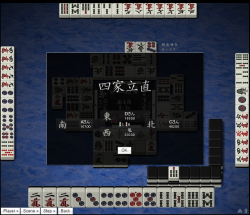Tochuu ryuukyoku
Tochuu ryuukoku (途中流局) is more commonly known as an abortive draw. Specific game situations end a kyoku (hand session) without any player declaring a win or drawing all tiles from the wall. With the exception of kyuushuu kyuuhai, all cases of tochuu ryuukoku are mandatory.
Consequences

In the event of tochuu ryuukoku, the current hand is instantly aborted. Furthermore:
- No points are exchanged between players; instead, the tiles are reshuffled again for the next hand.
- The noten penalty per exhaustive draw is not applied.
- Riichi declarers do not have to reveal their hand, except in face of four riichi.
- All riichi bets remain on the table and can be won during the next hand.
- As with an exhaustive draw, the honba count increases by one.
- Finally, the seat winds do not rotate for the next hand.
Essentially, play resumes as if the previous hand did not occur, except with the additional honba count.
Causes
The following screnarios cause an abortive draw.
Suufon renta
Suufon renta(四風連打), literally means "consecutively (ren) discarding (ta) four (suu) winds (fon)",is formed when at the beginning of the deal, East, South, West, North consecutively playing all the four tiles of the same wind in the first uninterrupted turn. At the moment North plays the fourth tile, the deal draws.
Kyuushuu kyuuhai
Kyuushuu kyuuhai(九種九牌), literally means 9 (kyuu) kinds (shuu) of honor or terminal (kyuu) tiles (hai). If a player's 14-tile hand after his initial draw is composed of 9 different honor or terminal tiles, the player may announce this and reveal his hand to abort the deal. This option is only available if no tile call has interrupted the initial turn earlier. Instead of calling kyuushuu kyuuhai, a player may play the hand normally, maybe aiming for kokushi musou. This is the only case where the call for tochuu ryuukoku is optional.
Suucha riichi
All four players call riichi and the 4th player's discard is not a winning tile.
As required with riichi declarations, all players must reveal their tenpai hands. Players without tenpai hands are punished with a chombo for declaring riichi while noten. After committing a chombo, the hand must be repeated, but no honba is added and all riichi declarers get one riichi stick back.
Suu kaikan
Kan is called four times by different players. If all four quads are called by one player, play continues as to give the player the opportunity to score the yakuman, suu kantsu. No other players are allowed to declare kan from then on. If the four quads have been formed by more than one player, hand abortion after formation of the fourth quad depends on the rules.
- Most rules abort the hand when the following discard is not a winning tile.
- Some rules end the game already on declaration of the fourth quad.
- Some rules may allow the game to go on, as if all quads had been declared by a single player. Usually, a fifth kan may not be declared at all, but when it is allowed, it immedeately aborts the game on its declaration.
Sanchahou
If three players call ron on the same discard by the fourth player, the hand is aborted and no player wins. However, variable rules may allow the use of the "Triple Ron", where the one unfortunate player pays points to all three hands.
External links
- Tochuu ryuukyoku in Japanese Wikipedia